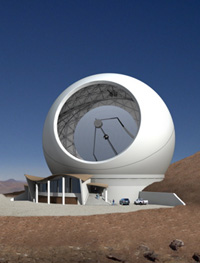 Concept image of proposed Cerro Chajnantor Atacama Telescope (CCAT) | |
| Alternative names | Cerro Chajnantor Atacama Telescope |
|---|---|
| Location(s) | Purico Complex, El Loa, Antofagasta Region, Chile |
| Coordinates | 22°59′09″S 67°44′25″W / 22.98592°S 67.74028°W |
| Altitude | 5,612 m (18,412 ft) |
| First light | 2023 |
| Telescope style | radio telescope |
| Diameter | 6 m (19 ft 8 in) |
| Website | www |
| | |
The Cerro Chajnantor Atacama Telescope (CCAT) is a proposed 25 metres (82 ft) diameter telescope that is intended to reveal the cosmic origins of stars, planets, and galaxies with its submillimeter cameras and spectrometers enabled by superconducting detector arrays.[1][2] The telescope was originally called the Cornell Caltech Atacama Telescope, but due to lack of funding the 25 metre telescope is currently on hold.[3]
The collaboration is building a smaller 6 metres (20 ft) diameter submillimeter/millimeter telescope, CCAT-prime, as a first step before pursuing the 25 metre CCAT at some (unknown) time in the future. CCAT-prime is based on a high optical throughput Crossed Dragone optical design,[4] and the Simons Observatory large aperture telescope uses the same optical design.[5] CCAT-prime will be located at the same site and share similar mission as the full sized CCAT, but naturally with reduced angular resolution compared to the 25 metre CCAT.
On September 14, 2020, the CCAT-prime telescope was renamed to be the Fred Young Submillimeter Telescope (FYST) after Fred Young, a Cornell alumnus who has supported the telescope for about two decades with over US$16 million.[6]
- ^ National Research Council Report Highly Recommends CCAT Archived 2011-07-28 at the Wayback Machine CCAT News 12 November 2010
- ^ Jonas Zmuidzinas bio NASA Accessed 28 March 2011
- ^ "CCAT Observatory: History".
- ^ Niemack, M. (2016). Designs for a large-aperture telescope to map the CMB 10X faster Applied Optics 55:7, 1688.
- ^ Parshley, S. et al. (2018). The optical design of the six-meter CCAT-prime and Simons Observatory telescopes Proc. SPIE 10700, 1070041.
- ^ "Breakthrough telescope in Chile renamed for benefactor alum".
